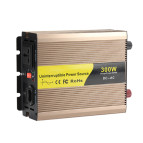Sine wave inverters are crucial for converting DC power from sources like batteries or solar panels into AC power, which is essential for running various household and commercial appliances.
When selecting a sine wave inverter, the first consideration is output power. The inverter's output power should exceed the combined power ratings of all appliances you intend to operate simultaneously. After determining your power requirements, it is recommended to choose an inverter with an output power approximately 1.2 times the calculated power to ensure a safety margin. Next, consider the battery voltage. The inverter's battery voltage must match your battery system's voltage. For example, if you have a 24-volt battery, select a 24-volt sine wave inverter.
Conversion efficiency is another key factor. Pay close attention to the inverter's conversion efficiency and opt for models with efficiency ratings above 85% to minimize energy loss during the DC-to-AC conversion process. Ideally, choose inverters with efficiencies exceeding 90%. Runtime is also important, as it depends on the battery capacity and the total power consumption of the connected devices. Ensure the battery has sufficient capacity to support the inverter and the required electrical equipment.
Surge power and continuous power ratings are equally crucial. Some devices require higher surge power at startup. Choose an inverter capable of handling these surge requirements. The continuous power rating indicates the maximum power the inverter can sustainably handle, ensuring it meets your total power needs. Additionally, be mindful of the peak power rating, which refers to the short-term power surge the inverter can handle. For devices with high startup surges, check the inverter's specifications to ensure compatibility.
The quality of the output waveform is another consideration. Pure sine wave inverters produce clean power similar to grid electricity, making them suitable for sensitive electronic devices such as computers and medical equipment. Functionality and safety are also important. Look for inverters with features like overload, short-circuit, over-temperature, and low/high voltage protection to enhance safety and reliability. Some inverters offer remote controls for convenient monitoring and operation.
Durability and reliability should not be overlooked. Choose reputable brands known for quality and reliability. Check the warranty period and customer support availability. Installation and usability are also key factors. Select inverters that come with clear instructions and necessary accessories for easy installation. If portability is required, ensure the inverter is lightweight and fits within the intended space.
In summary, choosing the right sine wave inverter involves understanding your power requirements, surge power needs, continuous and peak power ratings, output waveform quality, and safety features. Additionally, consider compatibility with your battery and solar system, conversion efficiency, and portability. Pure sine wave inverters are ideal for most applications, especially those involving sensitive electronics. By carefully evaluating these factors, you can select a sine wave inverter that meets your needs, ensuring a reliable power supply and extended equipment lifespan.
Houston, TX, 88459, Dubai, United Arab Emirates.
SineWaveInverters Listings
VIEW ALL
SEND MESSAGE
